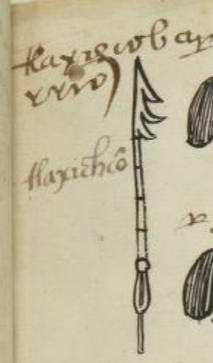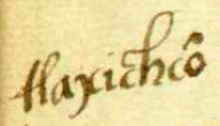Tlaxichco (MH526r)
This black-line drawing of the simplex glyph for the place name Tlaxichco features a vertical crossbow arrow (tlaxichtli). It has a distinctive, jagged point with three barbs. Like most arrows (mitl), this has a segmented cane shaft and is decorated with a wing feather and a down feather. The locative suffix (-co) is not shown visually.
Stephanie Wood
In the Matrícula de Huexotzinco, Tlaxichco is described as a barrio of Huejotzingo (aka Huexotzinco). Perhaps this is where the crossbow arrow (tlaxichtli) was made. The decoration on the arrow or dart is similar whether it is an acatl, a mitl, or a tlacochin. The tlaxichtli, shown here, is primarily shown in a way that emphasizes its barbed point, but at least this one from the Matrícula de Huexotzinco shows the same feathered decorations. See below.
Crossbows were introduced into Mesoamerica by Europeans. Some of them fell into Native hands during battles, along with swords, harquebuses, cannon, metal armor, etc. But even when these weapons were not captured and turned on the invaders, the Nahuas were interested in learning about them and the technology they represented. Still, this could be simply another Indigenous type of arrow. The (mitl, for example, is a common one, and sometimes it has a barbed point. The label of "crossbow arrow" comes from the translation by Alonso de Molina, so further research may be required to be sure that he was correct.
Stephanie Wood
tlaxichcō
Tlaxichco
Stephanie Wood
1560
Stephanie Wood
flechas, guerra, ballestas, tlaxichtli, nombres de lugares

tlaxich(tli), crossbow arrow, https://nahuatl.wired-humanities.org/content/tlaxichtli
En el Lugar de las Flechas de Ballesta
Stephanie Wood
Matrícula de Huexotzinco, folio 526r, World Digital Library, https://www.loc.gov/resource/gdcwdl.wdl_15282/?sp=131&st=image.
This manuscript is hosted by the Library of Congress and the World Digital Library; used here with the Creative Commons, “Attribution-NonCommercial-ShareAlike 3.0 License” (CC-BY-NC-SAq 3.0).




